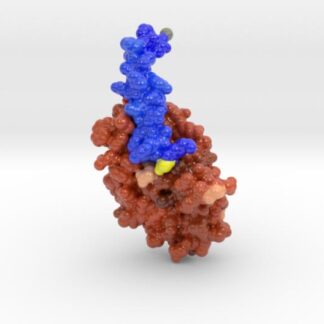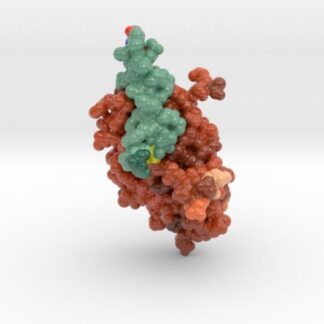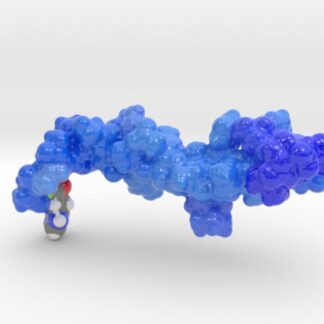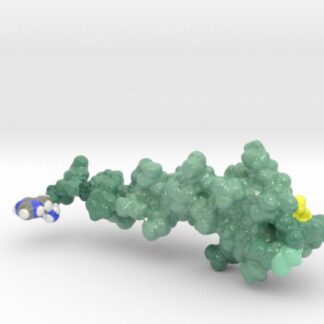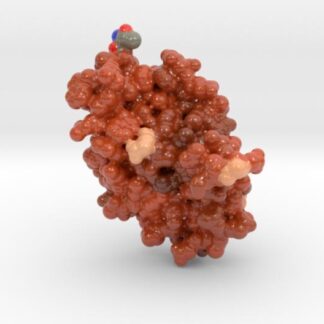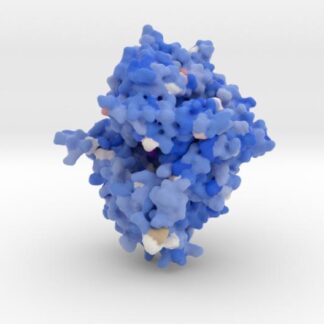GLP-1 Comparative Analysis
Use these 3D prints of GLP-1 to explain the incretin effect and compare GLP-1 to its analogs. The set includes the natural GLP-1 hormone, an natural animal analog, and synthetic drug.
Protein Description
“Glucagon-like peptide-1 (GLP-1) is a neuropeptide and an incretin derived from the transcription product of the proglucagon gene. The major source of GLP-1 in the periphery is the intestinal L cell that secretes GLP-1 as a gut hormone; the major source in the brain is the nucleus of the solitary tract, which is the source of a widely distributed set of GLP-1 projection neurons. The biologically active forms of GLP-1 are: GLP-1-(7-37) and GLP-1-(7-36)NH2. Those peptides result from selective cleavage of the proglucagon molecule.
GLP-1 secretion by ileal L cells is dependent on the presence of nutrients in the lumen of the small intestine. The secretagogues (agents that cause or stimulate secretion) of this hormone include major nutrients like carbohydrate, protein and lipid. Once in the circulation, GLP-1 has a half-life of less than 2 minutes, due to rapid degradation by the enzyme dipeptidyl peptidase-4.
GLP-1 is a potent antihyperglycemic hormone, inducing the β-cells of the pancreas to release the hormone insulin in response to rising glucose, while suppressing glucagon secretion. Such glucose-dependent action is particularly attractive because an unregulated release of the hormone when the plasma glucose concentration is in the normal fasting range, or poorly-timed insulin injections, can cause a dangerous fall in blood glucose (hypoglycemia). This does not happen as a result of GLP-1 because GLP-1 no longer stimulates the β-cells to release more insulin when blood glucose levels are in the fasting range. Additionally, GLP-1 appears to restore the glucose sensitivity of pancreatic β-cells.
The mechanism may involve increased expression of GLUT2 receptors on the surface of the β-cells; GLUT-2 is a carrier protein on the cell surface that facilitates the movement of plasma glucose across the cell membrane, allowing them to sense the level of glucose in circulation and release insulin when levels begin to climb. GLP-1 may also sensitize β-cells by increasing the expression of glucokinase, an enzyme in the β-cells that stimulates insulin production and release in response to glucose entering the cell. GLP-1 is also known to inhibit the programmed cell death (apoptosis) of pancreatic β-cells and to stimulate β-cell proliferation and differentiation. In addition, GLP-1 inhibits gastric secretion and motility. This delays and protracts carbohydrate absorption and contributes to a satiating effect.” ~Wikipedia
GLP-1 is hugely important to the body in order to successfully maintain euglycemia and ß cell maturation. To better understand how this protein successfully communicates its chemical message, let’s perform a comparative analysis of this protein bound to its receptor.
GLP-1 Analog Comparative Analysis
GLP-1 is an important hormone involved with the incretin signaling process. During meals, while digesting food, the stomach sends out a chemical signal in the form of incretin hormones like GLP-1 and GIP. These incretins travel to the pancreas and bind to GLP-1 receptors to signal ß-cells to release stores of insulin.
GLP-1 exists in two states, active and degraded. Degradation results after an enzyme called DPP-4 clips off the beginning 2 amino acids of the chain’s N-terminal. Of interest, the most structurally mobile region of GLP-1 are the amino acids near the N-terminal region of the protein (color colored by atom type).
Metabolic disorders result in poor absorption of glucose from the bloodstream. For this reason, GLP-1 is an important therapeutic target for the treatment of metabolic disorders like diabetes. To learn about the dynamics of this protein, scientists turned towards other examples of Glucagon Peptides in other organisms. Exenatide is a synthetic version of exendin-4, a hormone found in the saliva of the Gila monster and it’s a powerful binding agent of the GLP-1 receptor.
Adopting human GLP-1 to more effectively bind to the GLP-1 receptor is a novel modulation of a hormone to more effectively communicate its chemical message. Victoza is one such GLP-1 analog that reflects Exenidine’s angular binding region.
3D Print GLP-1 Analog Receptor Complex Models
Model is 3D printed in Full-color sandstone and available in Matte or Glossy UV protectant finish and available in multiple sizes.
3D Print GLP-1 Analog Models
Model is 3D printed in Full-color sandstone and available in Matte or Glossy UV protectant finish and available in multiple sizes.
3D Print DPP-4 MOA Models
Model is 3D printed in Full-color sandstone and available in Matte or Glossy UV protectant finish and available in multiple sizes.
Custom 3D Print Request
Request a custom 3D printed protein model. Send us the protein name and PDB ID of the protein you’re interested in printing and we’ll get back to you with a feasibility analysis and estimate for printing.
[ninja_form id=6]





